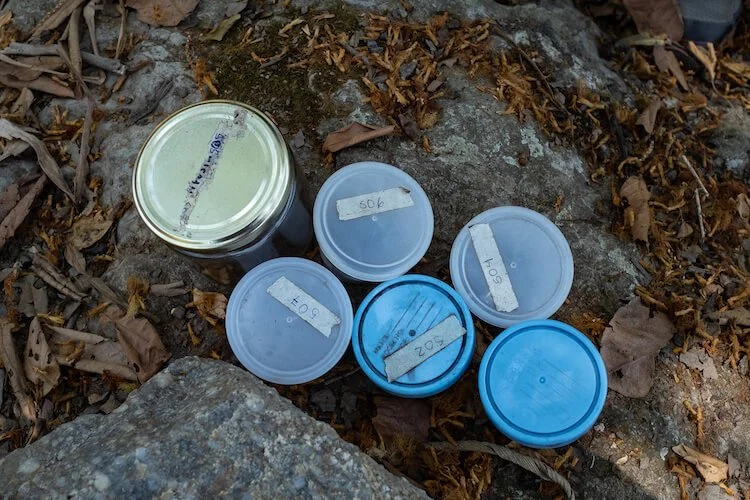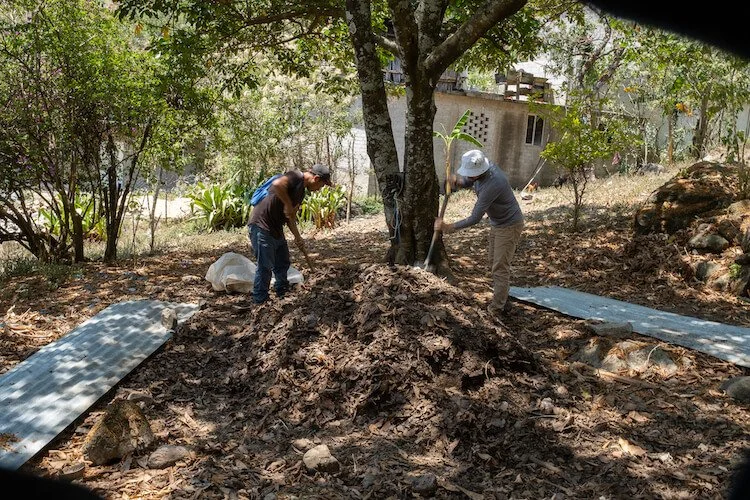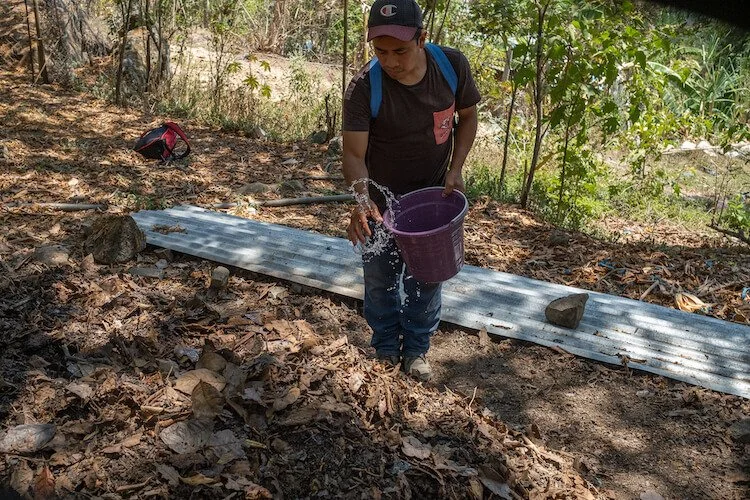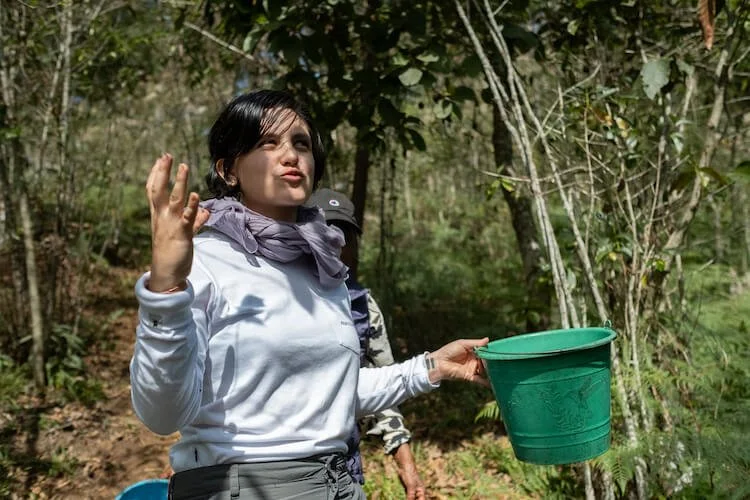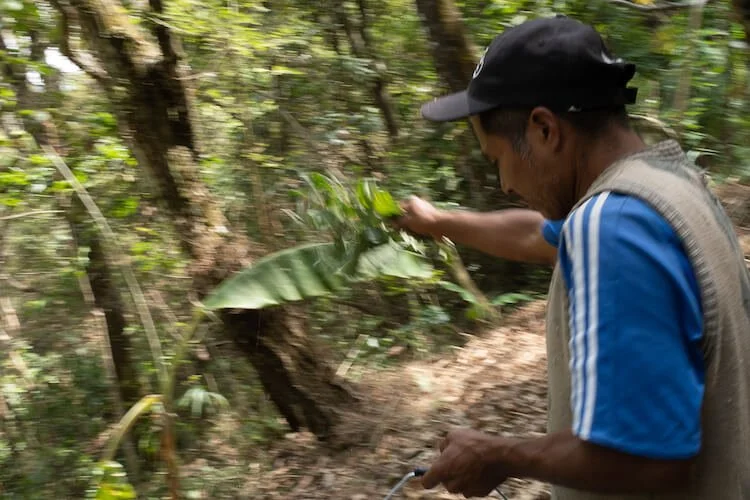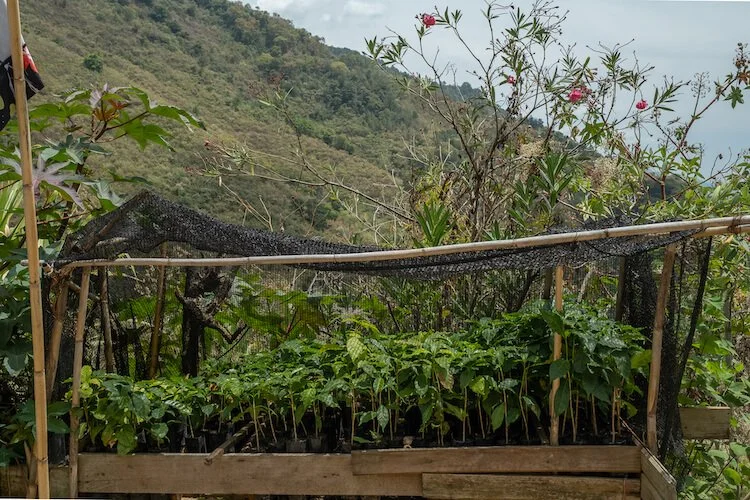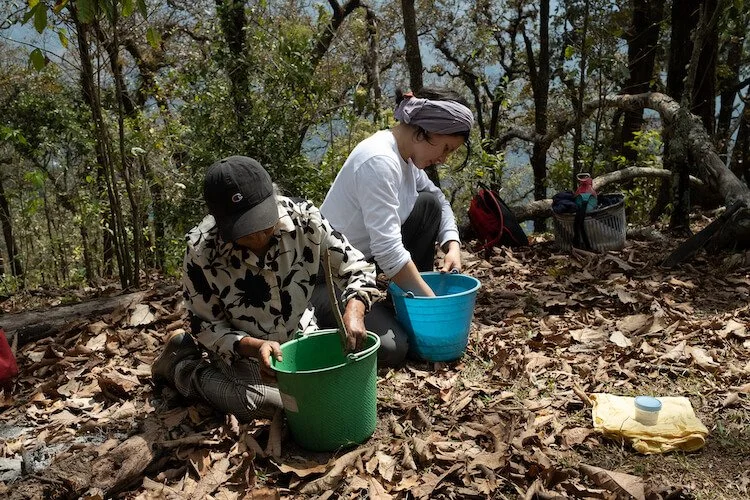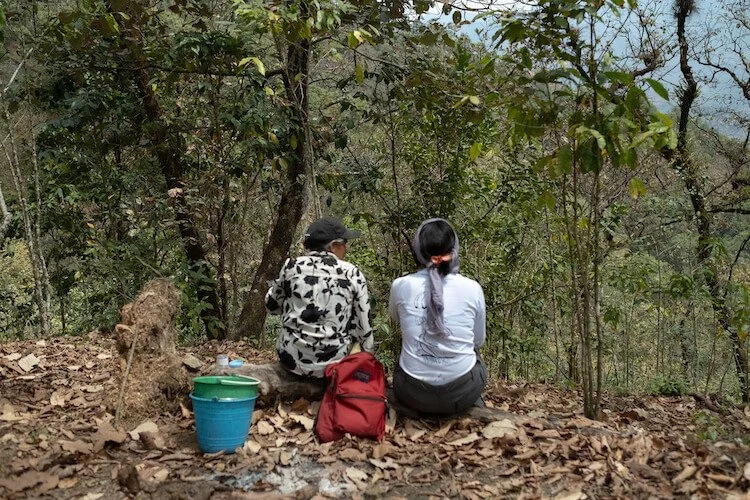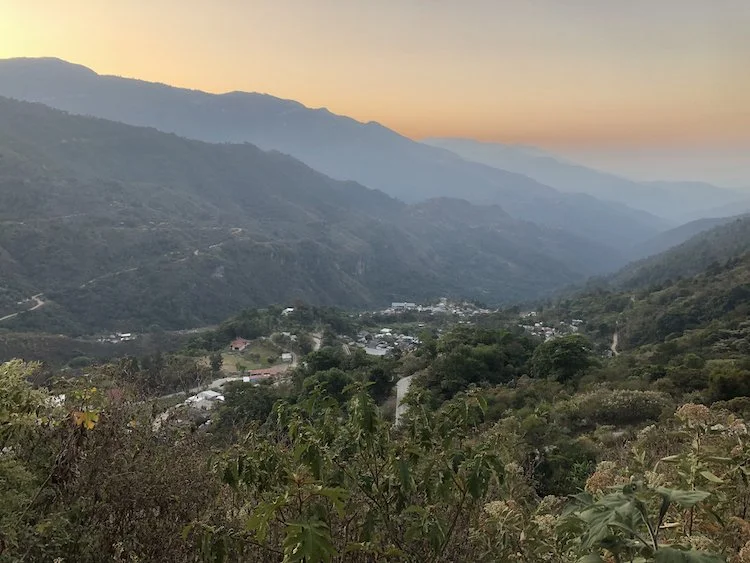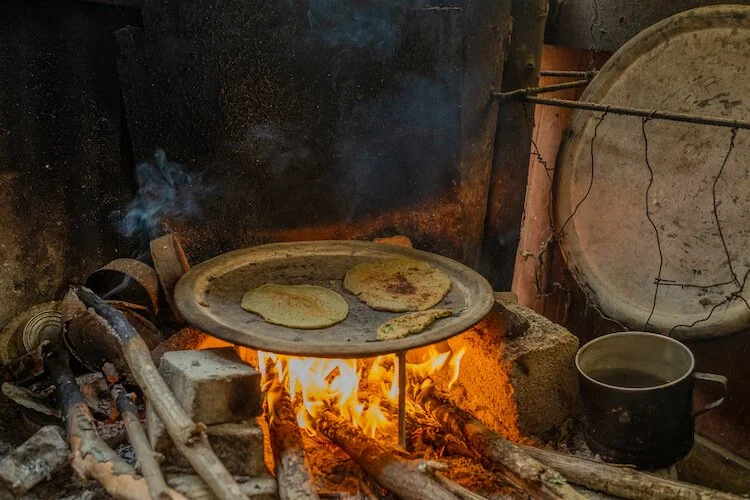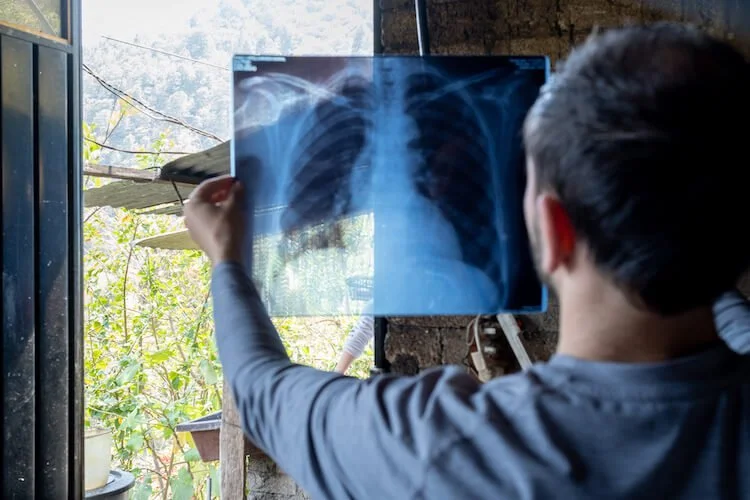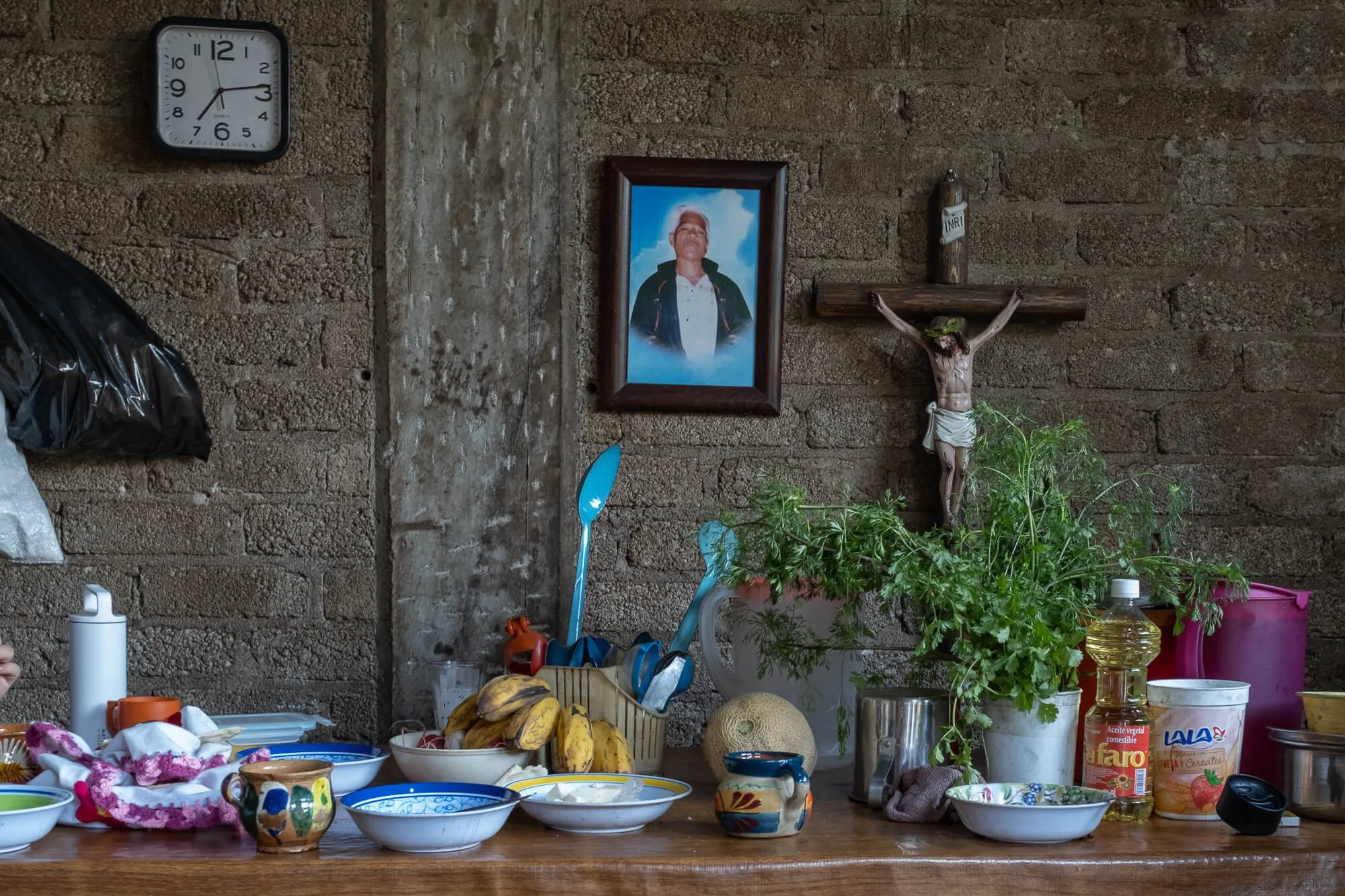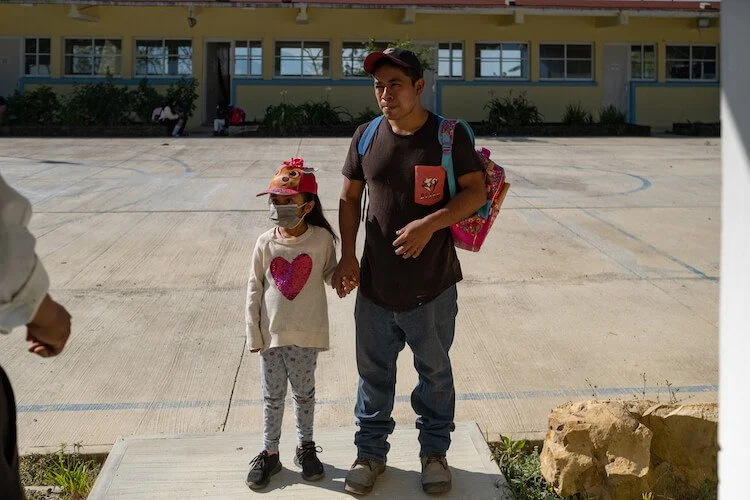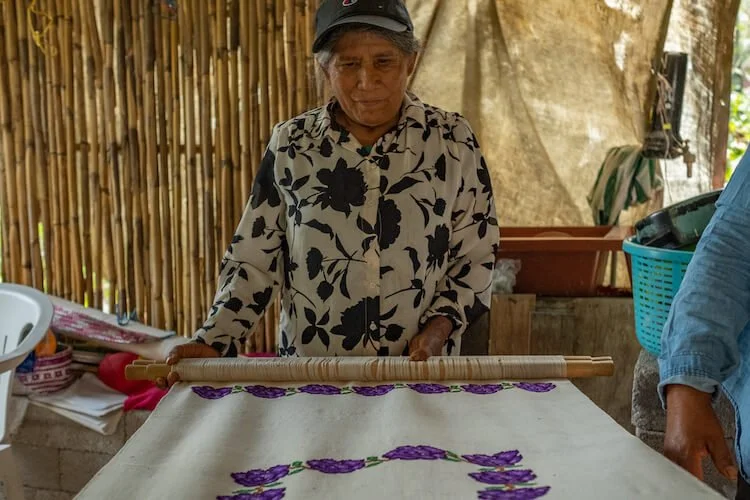Teikei Coffee, Germany/Mexico
COFFEE CONNECTION
by MAREN PREISS
Coffee is the fuel that keeps us moving. About 90 percent of humans ingest caffeine regularly, making it the most widely used psychoactive drug in the world. Therefore it comes as no surprise that coffee is among the most traded commodities in the world. As a cash crop it is primarily grown for the purpose of profit. In 2022, global sales amounted to 387 billion euros. The way from the red cherries on the coffee plants to a cup filled with a steaming fragrant drink is long, and many people make a healthy profit along the way: processors, exporters, shipping companies, importers, roasters, coffee shops.
Everyone, except the coffee farmers who do the hardest part of the job because their work can be automated only to a limited extent. The farmers grow the seedlings, they take care of the soil and the plants, harvest the cherries by hand, gather them in baskets, which strap run around their foreheads; carry those often upon the steep hills of the plantation, they process the cherries in the wet mill and finally dry the beans. And yet it is still a fact that coffee farmers are the weakest part of the global industrial coffee trade. It was colonialism that has shaped the coffee sector of today.
In today’s coffee trade most of the smallholders are dependent on local businessmen, the so-called coyotes, who buy the coffee at a price that is based on the fluctuating world market price, which in most of the cases is very low. A farmer who sells his coffee to a coyote will generally not just earn very little, he will also never know in which country his coffee is sold and in whose cup it is poured. On the other side coffee drinkers are seldom aware of their responsibility for these unjust conditions. Less than 5 per cent of worldwide turnover is achieved with fair trade. But luckily there are people who not only dream of a fairer world but do their part to make it a reality.
Hermann Pohlmann is such a person. He is the head of the CSA Teikei Coffee, a small company based in Hamburg. In contrast to traditional trading houses, Teikei Coffee is breaking new ground: the company buys its raw coffee from indigenous coffee farmers in Santiago Nuyoó in the Mixteca Alta region of Oaxaca, Mexico, working according to biodynamic and CSA principles.
Hermann Pohlmann committed himself to Community Supported Agriculture four decades ago. A trained sculptor and an admirer of Joseph Beuys’ concept of the social sculpture, he was one of the first to apply the CSA principle on a global level. Today he lives and works in Mexico. In a business that for centuries has been characterized by colonialism and exploitation, Pohlmann aims to make the coffee trade fairer by inviting consumers to take their share of the responsibility in coffee production.
With his CSA he brings producers and coffee enthusiasts closer together: about 1000 coffee drinkers in Germany and Switzerland are members of his CSA, founded in 2016. By pre-financing their share of the harvest through a one-year commitment they ensure 30 coffee farmers in the Sierra Mixteca in Mexico a livelihood. Farmers get a fixed price, independent from the world market price, and they have the certainty that their coffee will be purchased at this price. In addition the farmers are invited to participate in the agricultural workshops where they find the Teikei team ready to listen to their concerns.
“Teikei is a pilot project that shows that things can be done differently. The smallholder economy is the future of the economy because unlike the global industrial trade it’s able to feed the people.”
Teikei Coffee also makes a great contribution to sustainability. Once a year the raw coffee beans are shipped by sailboat from Mexico to Hamburg. The vision of Hermann Pohlmann and his son and co-founder Aaron Li Küppers, who runs the Teikei Café in Hamburg would sound naïve if you didn’t know that they work hard to reach their goal. They always dared to dream big – basic requirement for initiating change: “Imagine drinking a coffee that is traded on equal terms. Imagine that the coffee farmers get the price they need for their work; that your coffee from the mountains of Mexico is of the highest quality. Imagine that the coffee plants are growing in healthy, living soil; that your coffee is transported by sailboat with the power of the wind. Imagine that you are part of an international Community Supported Agriculture and of a lively community.”
Pohlmann and Küppers have already come a long way on this path. Unlike the coyotes, Teikei Coffee relies on close long-term relationships with their Mexican coffee farmers. Up to four times a year Hermann Pohlmann travels with two Mexican friends, the biologists David Akle Cantú and Ana Laura Aguila, to the village of Santiago Nuyoó and its surroundings where the 30 smallholders live and grow their coffee exclusively for Teikei. Akle Cantú and Aguila are the CEOs of Marchantia, a company that acts as a link between cup and origin. The two biologists are aiming to improve quality and ecosystem health, for Teikei they also take care of the logistics.
In March 2022 I accompanied the trio in a nine-hour drive from Mexico City to the village of Santiago Nuyoó, Oaxaca, and got a glimpse of the spirit of a global CSA and also of biodynamic farming. On my arrival the harvest was already done. I followed three coffee farmers in their daily work on their coffee plantations. I was invited into their homes, I accompanied the work in the warehouse and attended a lesson in the primary school of the village where the children of the coffee farmers are taught.
Apart from poor conditions and tangible problems such as education, access to proper health care and housing, what impressed me most about the people of Santiago Nuyoó was their devotion to their work, their thirst for knowledge, their community spirit and their deep bond with nature. I encountered warmth of heart, humility and beauty on many levels. It was great to see how in this small transatlantic coffee alliance that is the global CSA, the farmers of Santiago Nuyoó are partners, not subjects to exploit.
But how do you measure its success? Perhaps best by coffee farmer Eliceo’s smile after I passed him my phone. On the screen a picture of Matthias from Hamburg, a member of the CSA since the beginning, greeting the farmers of this remote village in the high mountains of the Mixteca Alta, 9600 kilometres far from Hamburg.
The Coffee Farmers
Gil Sarabia Pérez, 35, coordinates the work of the Teikei coffee farmers. He works on the plantations, as well as in the Teikei warehouse where the coffee bags with the dried beans are stored temporarily before being trucked to the dry mill in Oaxaca. His plantation Nu’yu Ku Ka’nu is two hectares in size, he takes care of 2500 productive plants. In 2022, he harvested 550 kilos of raw coffee.
“Our coffee plants are old, the production has gone to a low amount. If we hadn’t met Teikei we probably would have chosen the chemical pathway because we already have eroded soil. But now they are teaching us how to take the organic pathway. They reinforce in us what we already knew: Our ancestors worked in the coffee without pesticides. The biodynamic approach helps us to stay healthy.”
Gil tells his story (Spanish/Mixtec)
Herminia Gloria Lopez Bautista, 70, while listening to David‘s lecture. In her hand she holds a sample of horn manure, in the biodynamics known as “500” which is obtained by the transformation of high-quality cow manure that has been put into cow horns and buried under the earth during the winter.
Herminia likes the workshops Teikei offers to the farmers. She is very eager to learn because she never attended a school. “Here nobody teaches us how to practice agriculture in the right way”, she said. “I remember the first time when we had a workshop with Teikei. I was taught how to produce the compost and how to apply it. I liked it because you can really see the difference in the coffee plant.” Herminias plantation Nu’yu Ku measures two hectares, she takes care of 1000 productive plants. In 2022, she harvested 74,8 kilos of raw coffee.
Herminia tells her story (Spanish)
Eliceo Vázquez Sarabia, 50, lives outside Santiago Nuyoó, in Plan de Zaragoza. His plot of land named Chite Yoxt is two hectares, he owns 2000 productive plants. Nevertheless, in 2022, his crop only amounted to 106,8 kilos. Eliceo has lost many coffee plants due to coffee leaf rust – the worst foliar disease for any coffee farmer, caused by a fungus.
“The most difficult thing for a coffee farmer is the beginning of production. You have to raise the plant from the seed to the seedling and then from the seedling in the nursery to the tree on the coffee plantation. It takes more than three years until the first harvest. You have to be very careful, if you don’t do it correctly, then all the work you put into it for years was for nothing. And you have to start all over again.”
Eliceo tells his story (Spanish/Mixtec)
Teikei Coffee works according to biodynamic principles and practices. In his workshops biologist David Akle Cantú teaches the coffee farmers about the effects of the different preparations. The biodynamic approach, which is based on the understanding of the connection between environment and cosmos and how this influences the growth and development of the plants, falls on fertile ground: the cosmology of the Mixtec farmers is based on the idea that agriculture is closely connected to the cosmic order. The people are especially related to the cycle of the moon. This can even be read from the name of the village, Santiago Nuyoó. In the Mixtec language “Nuyoó” means “face of the moon” .
Primary school teacher Secundino Martin Santiago Pérez presents the works of the children whose task was to paint the planetary system.
Essential tool in biodynamic farming: the astronomical calendar.
In Mexico, 80% of forests, equivalent to 55.3 million hectares, are owned by 30.000 traditional communities in which agroforestry systems are practiced. On the plantations in Santiago Nuyoó and its surroundings the coffee plants are grown under the shadow of trees such as Pine, Oak, Liquidambar and Inga Densiflora, a very common shade tree in Central America. This tree with its beautiful white flowers, has a positive impact on the microclimate, the yield and the vegetative development of shaded coffee. The bees love Inga as well. The farmers work in the middle of an extraordinary soundscape.
The traditional small-scale agriculture of indigenous people is often accused of being the main cause of poverty – too unproductive, economically unprofitable, not suitable to feed the people sufficiently, and responsible for the destruction of the environment are the main allegations. It is true that in recent years, the frequency of land slides has increased, but this was a result of high-magnitude rainfalls due to changes in climatic conditions. This much is certain: climate change was and is not caused by native people. So it is more likely that the opposite comes closer to the truth: indigenous people are the main promoters of food sovereignty. They not only have control over food and its means of production. Their agroforestry systems have also great advantages in terms of conserving biodiversity and the integrity of ecosystems. What communities of natives need most is an access to the market which is based on partnership instead of exploitation. And what Western cultures need most is to learn to listen to the wisdom of indigenous people.
“My God is present in the land, in the air I breath, in the light, in the water. This is what keeps me and my family alive. In my vision of life earth is sacred because the earth lives for me. If you treat nature well and nourish her, she responds fast and I will harvest a lot.”
—Eliceo Vázquez Sarabia
Mexico is a stronghold of biodynamic farming. The wisdom of the Aztec empire developed in pre-Hispanic times found also expression in the agriculture. By observing the cosmos the Aztec priest Tlacaelel managed to bring the human to open up for spirituality. Aztec remedies are similar to the biodynamic preparations developed in Europe. These preparations made a great contribution in developing biodynamic agriculture in Mexico. The same goes for the knowledge reflected in the Aztec sun stone, better known as Aztec calendar.
In the short film we see biologist Ana together with the farmers Herminia and Gil during a key practice in biodynamic farming: dynamizing. Beforehand, some horn manure was added to the water in the bucket. Then the preparation is stirred in one direction until a vortex is formed. Then it is stirred in the opposite direction.
The idea behind stirring is to transfer the so-called etheric formative forces from the preparations to the land. It is believed that water keeps the “memory” of the dissolved biodynamic preparation and that this information can thereby be transferred to the soil.
The stirring brings also a substantial increase of oxygen and helps microbes inside the horn manure 500 doing their effect. Biodynamic farmers also believe that by stirring by hand your feelings are transfered to the water – the reason why David plays the flute and tries to create a positive and relaxed atmosphere during this key process in biodynamics.
Connecting the Dots of Intercultural Wisdom
Coffee farmer Gil Sarabia Pérez is a second generation coffee farmer and a trained engineer who knows the bigger cities and the universities well. But he couldn’t cope with the rhythm of the city. When I asked him: What is a good life for you?, he answered: “Staying with my family.” Here we see him with his wife Areli Sandra, his daughter Neli Isabel and the two months old Carlos Damián. The young family shares the house with Gil's mother, his brother and his sister-in-law.
Coffee farmer Eliceo Vázquez Sarabia with his wife Graciela, their two sons Rafael Ricardo and Eric Jonathan and their daughter Arely. The family sleeps together in a small room built of wooden slats. Two beds for five. They live outside Santiago Nuyoó, in the remote Plan Zaragoza in the middle of a breathtaking landscape. It takes the boys more than two hours on foot to reach the school. “Do you want to become a coffee farmer as well?”, I asked the eldest, Eric Jonathan. “Only if I don’t find another job”, he responded. At Teikei they hope that the next generation of coffee farmers will benefit from the CSA model and that the profession becomes more attractive for young people.
Herminia Gloria Lopez Bautista proudly presents the handwoven festive dress of the Mixtec women. In the background her granddaughter Aleydis. Herminia lives together with her son, her daughter-in-law and her granddaughter. Craftmanship is the great passion of the three women. They weave colourful fabrics on a mobile weaving frame that they attach to a wooden pillar and tie around their back. Herminia also spins wool and sells it at the local market. She would never leave her village for the amenities of a big city. “Who then would take care of my fields and my animals?”, she said.
View from Gil’s house in the Sierra Mixteca.
End of March the 60-kilogram coffee bags were transferred from the warehouse in Santiago Nuyoó to the truck that later in the night set off for the dry mill in Oaxaca. There the coffee beans are released from their husks. But before the processing in the dry mill can start, the truck must be unloaded, the content of the 60 kilo coffee bags be checked, weighed and piled up on the Teikei batch – by human physical power. The green coffee gained after processing is trucked to the port of Puerto Progreso where the sailing ship “Avontuur” of the Timbercoast Shipping Company awaits the precious commodity for transport across the Atlantic Ocean to Hamburg where some members of the CSA await the sailing ship and help with the unloading of the coffee bags.
A moment of pride: Gil takes a photo of the batch of coffee bags the 30 farmers harvested for Teikei in 2022.
Photos, Videos, Text, Audio, Layout: Maren Preiß, marenpreiss.de
Infographic: Jelka Lerche, jelkalerche.de
Background picture of the starry sky: Paul Volkmer, unsplash image
All rights reserved.
A big thank you to Hermann, David and Ana for their support and to Gil, Herminia and Eliceo who opened the doors into their lives for me.
The research was funded by the program "Neustart Kultur”, financed by the German Federal Government Commissioner for Culture and the Media.













